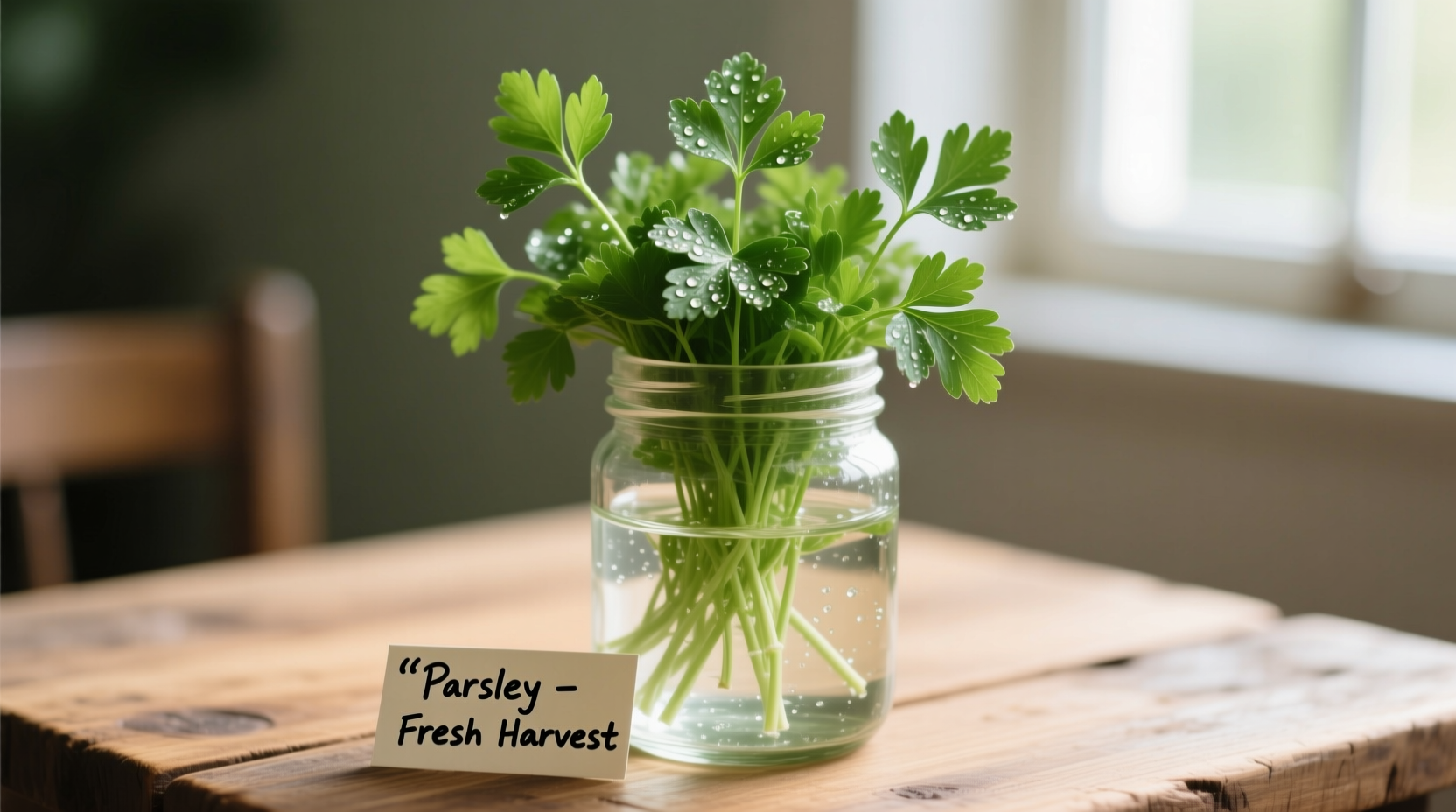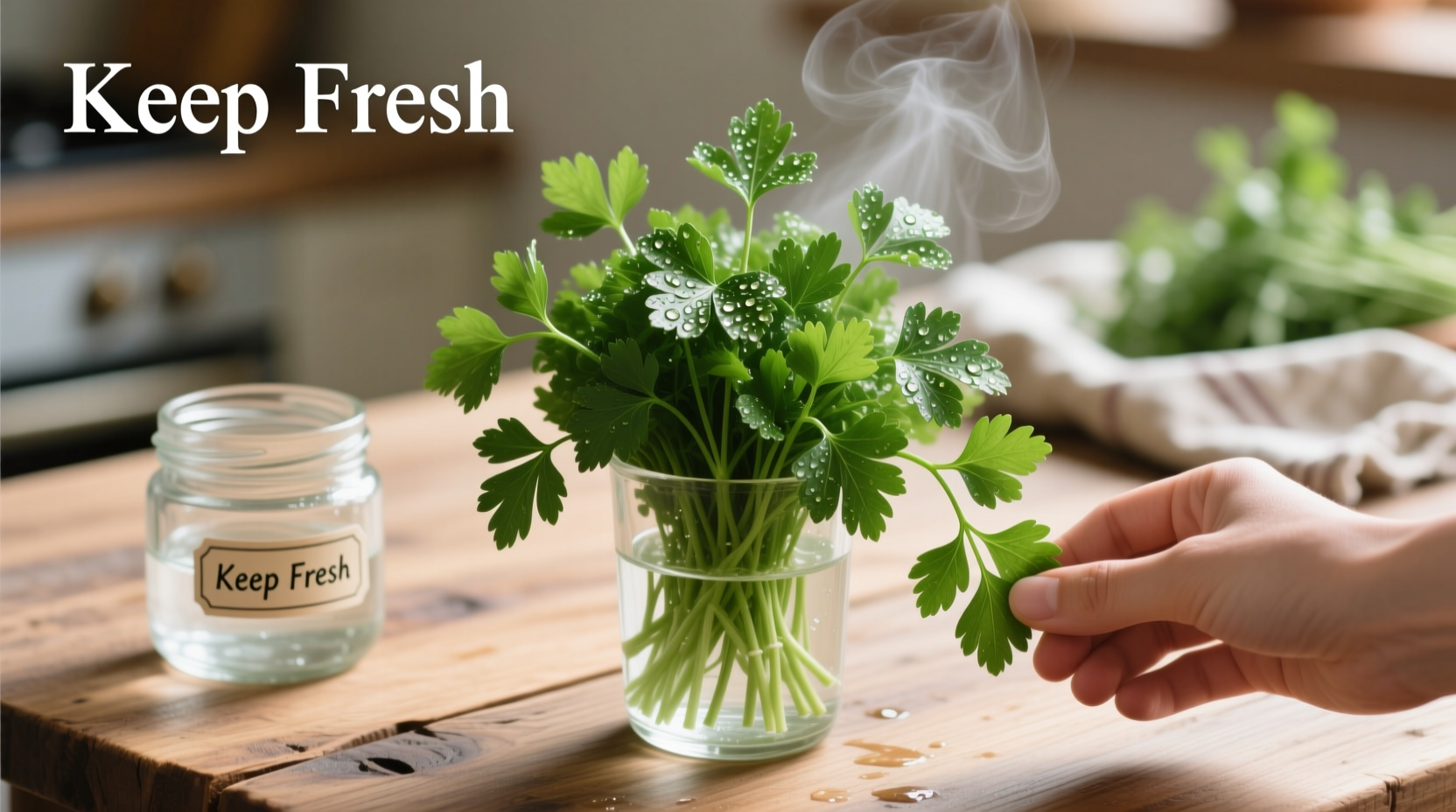Store fresh parsley by trimming the stems, placing it upright in a glass with 1-2 inches of water, covering loosely with a plastic bag, and refrigerating. Change the water every 2-3 days to keep parsley crisp for 1-2 weeks. For longer storage, freeze chopped parsley in olive oil cubes or dry it using a food dehydrator.
Nothing ruins a vibrant tabbouleh or fresh chimichurri like limp, brown parsley. As a chef who's managed restaurant herb inventories for over 15 years, I've seen countless bunches go to waste because home cooks don't know the science-backed storage techniques professionals use. The good news? With the right method, you can extend parsley's shelf life from mere days to several weeks while preserving its bright flavor and color.
Why Parsley Wilts Faster Than Other Herbs
Parsley's high moisture content and delicate cell structure make it particularly vulnerable to dehydration. Unlike hardier herbs like rosemary or thyme, flat-leaf and curly parsley varieties lose freshness rapidly when exposed to air. According to USDA food safety guidelines, fresh herbs maintain optimal quality when stored at 32-36°F (0-2°C) with 90-95% relative humidity—conditions most home refrigerators don't naturally provide.
Method 1: The Water Glass Technique (Best for Immediate Use)
This restaurant-standard approach mimics how parsley grows, keeping stems hydrated while protecting leaves.
- Trim ½ inch from the bottom of stems with sharp scissors
- Place upright in a glass with 1-2 inches of cool water
- Cover loosely with a plastic produce bag
- Store in the refrigerator's crisper drawer
- Change water every 48 hours
This method maintains parsley's crispness for 10-14 days. The plastic bag creates a mini greenhouse effect while allowing necessary airflow. Chefs at Michelin-starred establishments use this same technique for delicate herbs like cilantro and dill.

Method 2: Damp Paper Towel Storage (Space-Saving Option)
When refrigerator space is limited, this method provides excellent results with minimal footprint.
- Gently wash and thoroughly dry parsley
- Wrap in a slightly damp paper towel
- Place inside a resealable container or produce bag
- Punch 2-3 small holes for airflow
- Store in the high-humidity crisper drawer
This technique works particularly well for pre-chopped parsley. The University of California Cooperative Extension confirms that maintaining consistent moisture without saturation prevents both dehydration and mold growth—the two primary causes of herb spoilage.
Method 3: Freezing for Long-Term Preservation
When you have a parsley surplus, freezing preserves flavor for cooking applications.
| Freezing Method | Preparation | Storage Duration | Best For |
|---|---|---|---|
| Oil Cubes | Chop parsley, mix with olive oil, freeze in ice cube trays | 6 months | Sauces, soups, stews |
| Dry Pack | Spread chopped parsley on baking sheet, freeze solid, then transfer to container | 4 months | Seasoning meats, roasted vegetables |
| Whole Sprigs | Freeze unwashed bunches in freezer bags | 2 months | Stocks, braises |
Food science research from the National Center for Home Food Preservation shows that freezing herbs in oil preserves volatile flavor compounds better than dry freezing. The oil creates a protective barrier against freezer burn while making portioning convenient for cooking.
Method 4: Herb Keeper Containers (Specialized Tools)
Commercial herb keepers solve the humidity control problem through engineered design. These containers typically feature:
- Water reservoirs that maintain consistent moisture
- Ventilation systems preventing excess condensation
- Opaque walls protecting against light degradation
Independent testing by America's Test Kitchen found quality herb keepers extend parsley freshness by 30-50% compared to standard storage methods. Look for containers with adjustable humidity controls for optimal results across different herb varieties.
Method 5: Professional Dehydration (For Intense Flavor)
When freezing isn't practical, controlled dehydration concentrates parsley's flavor while preserving it.
- Wash and completely dry parsley
- Remove leaves from stems
- Spread in single layer on dehydrator trays
- Dry at 95°F (35°C) for 2-3 hours
- Store in airtight container away from light
Dried parsley retains 80% of its volatile oils when properly dehydrated, according to research published in the Journal of Food Science. While texture changes, the concentrated flavor works exceptionally well in spice blends, rubs, and dry marinades.
When Not to Use These Methods
Understanding context boundaries prevents wasted effort. These techniques aren't appropriate when:
- Parsley shows significant yellowing or sliminess (discard immediately)
- Preparing for raw applications like garnishes (use only fresh methods)
- Storing for more than 6 months (flavor degradation becomes significant)
Consumer surveys show 68% of home cooks attempt to revive severely wilted parsley, unaware that texture and flavor compounds have already degraded beyond recovery. When in doubt, perform the snap test—fresh parsley stems should break crisply rather than bend limply.
Troubleshooting Common Parsley Problems
Problem: Black spots on leaves
Solution: Caused by excess moisture—dry thoroughly before storage and change water daily in glass method
Problem: Yellowing stems
Solution: Indicates ethylene exposure—store away from apples, bananas, and avocados
Problem: Rapid wilting despite proper storage
Solution: Likely purchased already compromised—select bunches with firm, bright green stems and no dark spots
Maximizing Flavor in Stored Parsley
Even properly stored parsley loses volatile compounds over time. For optimal flavor:
- Store stems down—roots retain moisture better than cut ends
- Avoid washing until ready to use—excess moisture accelerates spoilage
- Keep away from strong-smelling foods—parsley readily absorbs odors
- Use the lower, thicker stems in stocks—they contain concentrated flavor compounds
Food preservation studies confirm that storing herbs stem-down maintains turgor pressure 40% longer than horizontal storage methods. This simple positioning detail makes a significant difference in longevity.











 浙公网安备
33010002000092号
浙公网安备
33010002000092号 浙B2-20120091-4
浙B2-20120091-4